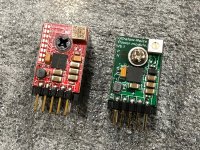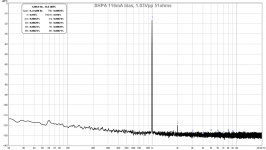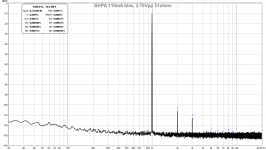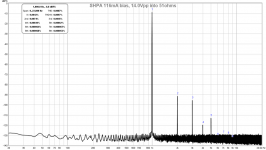Is that thing legit? That would be awesome to have around. How much?
$250 Kickstarter. It looks real - what is of concern is how they get this past ANSI laser safety standards for commercial products. There is no safety shield and this can burn eyes easily.
Last edited:
Very true. I guess they thought the "cool" safety glasses might impact their marketing video. Haha! They do show it with a shielded enclosure on the kickstarter page. Cubiio: The Most Compact Laser Engraver by Muherz —Kickstarter
Last edited:
I was on travel all last week and basement is still undergoing repairs so could not get anymore progress on the verification build. I just need to install output MOSFETs and drill and tap heatsink and connect cables. Will try to get first sound by end of this week.
I was on travel all last week and basement is still undergoing repairs so could not get anymore progress on the verification build. I just need to install output MOSFETs and drill and tap heatsink and connect cables. Will try to get first sound by end of this week.
I was wondering where your superhuman build speed had gone...😛
Hi X,
neg is green (TPS7A3301 and only potentiometer).
pos is using BOURNS 3324J potentiometer expensive one!
JP
neg is green (TPS7A3301 and only potentiometer).
pos is using BOURNS 3324J potentiometer expensive one!
JP
Hi JP,
Those 3324J’s are $4ea! More than an RK09 volume pot. Not kidding. I know the TPS7A’s are about $5ea, and the 10uF x7R caps are not cheap either. So all in all, $20 ea is a very fair price for these. These also have a small inductor on the enable pin. I wonder what that’s for?
Those 3324J’s are $4ea! More than an RK09 volume pot. Not kidding. I know the TPS7A’s are about $5ea, and the 10uF x7R caps are not cheap either. So all in all, $20 ea is a very fair price for these. These also have a small inductor on the enable pin. I wonder what that’s for?
Hi X,
seems that inductor is at input/output (don‘t know exact pinning) so for filtering purpose?
JP
seems that inductor is at input/output (don‘t know exact pinning) so for filtering purpose?
JP
Looking at pins it is connected to input pins (2 on positive and 3 on negative). 1 is enable and can be removed and shorted. I assume pin 4 is out on either and 5 is optional feedback pin. So looks like an LC filter on the input to clean up the source even more.
I just looked up the pinouts. The first one (from left) is the enable, next 3 conform to 78xx and 79xx (that is +input, GND, +output for positive 78xx; GND, -Input, -Output for 79xx), and pin 5 is GND.
So should be simple matter to snip off pins 1 and 5 and jumper pin 1 pad to input.
So should be simple matter to snip off pins 1 and 5 and jumper pin 1 pad to input.
Verification build completed
I finally had a good day to work on this amp. The build went together well. It's a big project with all the little sub boards. There is an error on the volume pot board - one of the pads on the smaller right channel is not connected to anything - jumper it to the right input. The crossfeed filter has some errors - I managed to fix it partially so that it works but the defeat feature does not fully defeat it. Sounds great. Bias is 116mA with +/-17.5v under load. DC offset is -2mV and 6mV.
Completed amp before buttoning up:
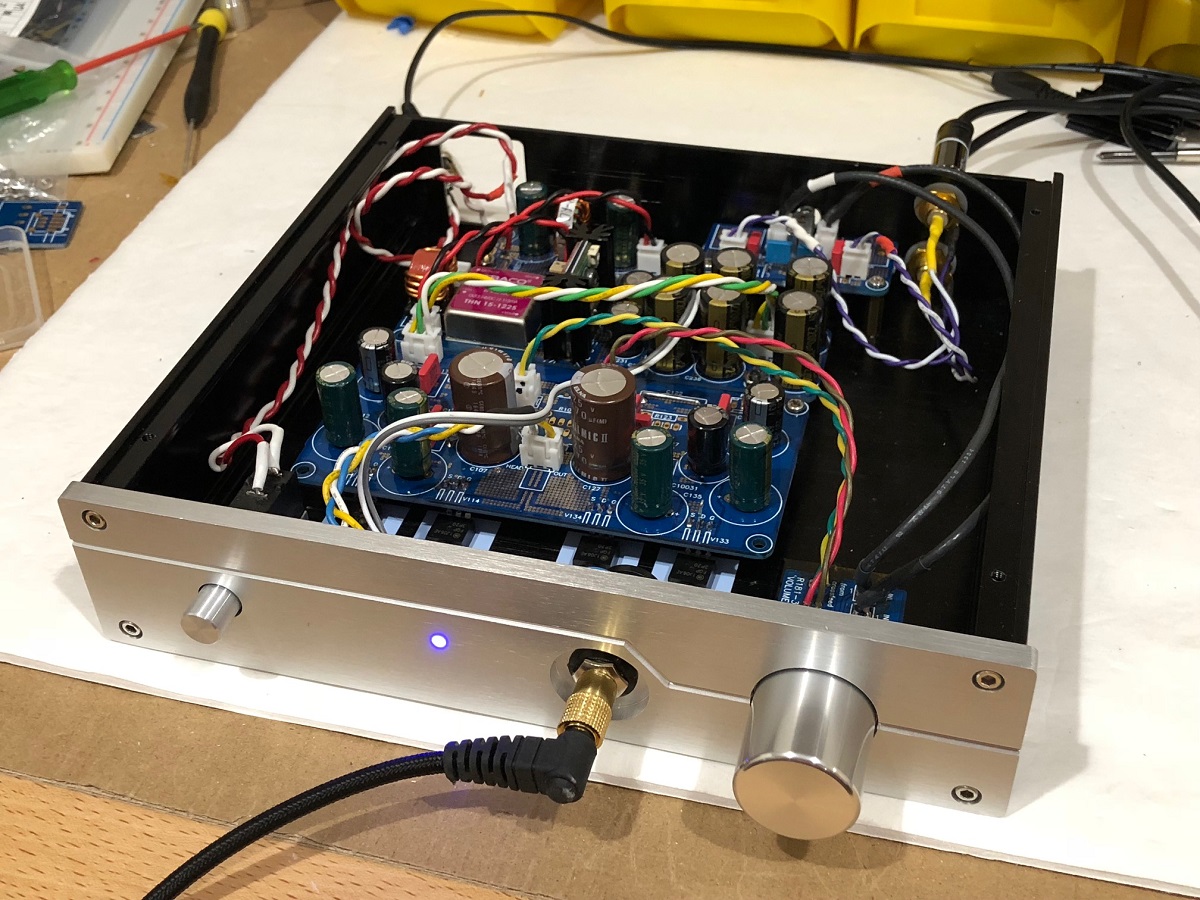
Closeup:
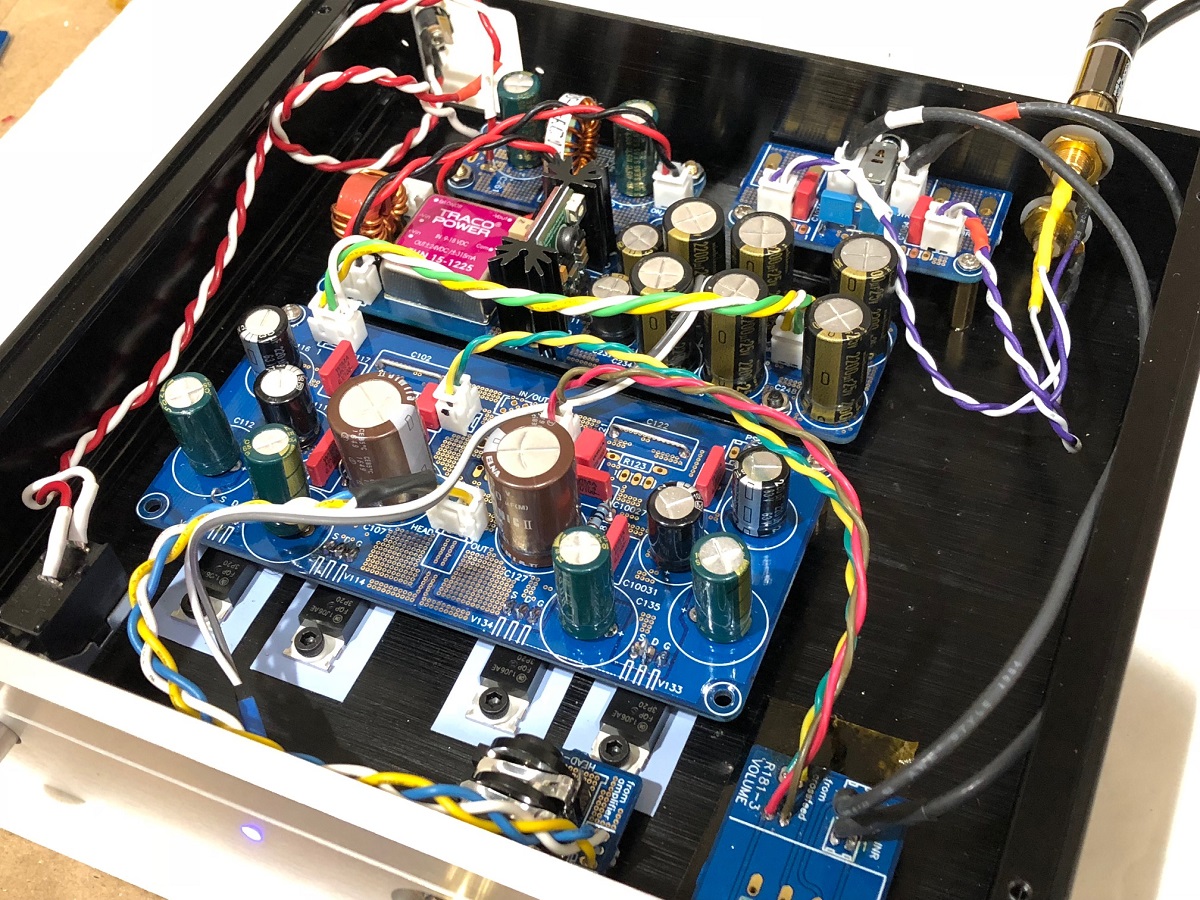
Closeup of ebay voltage regulator (negative one):
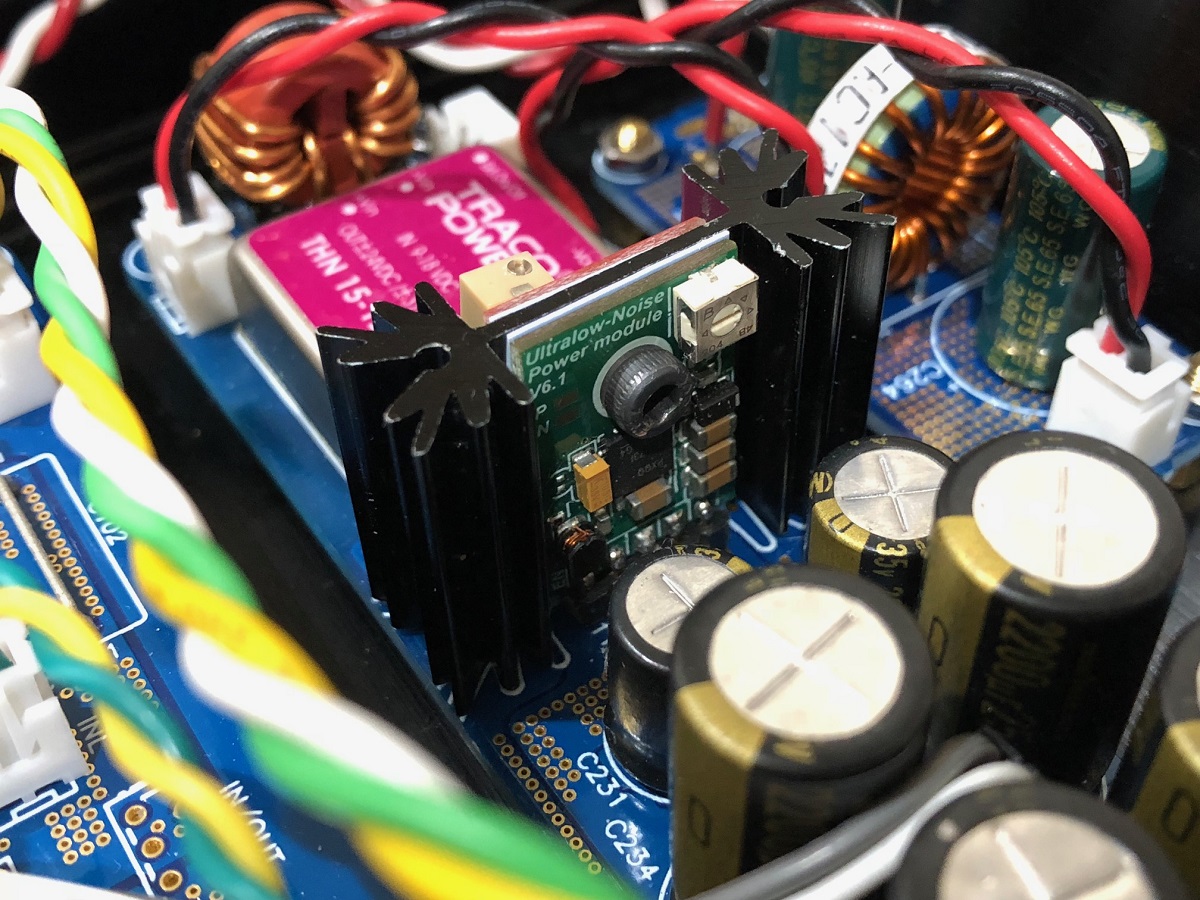
Closeup of outputs and heatsink mounting:
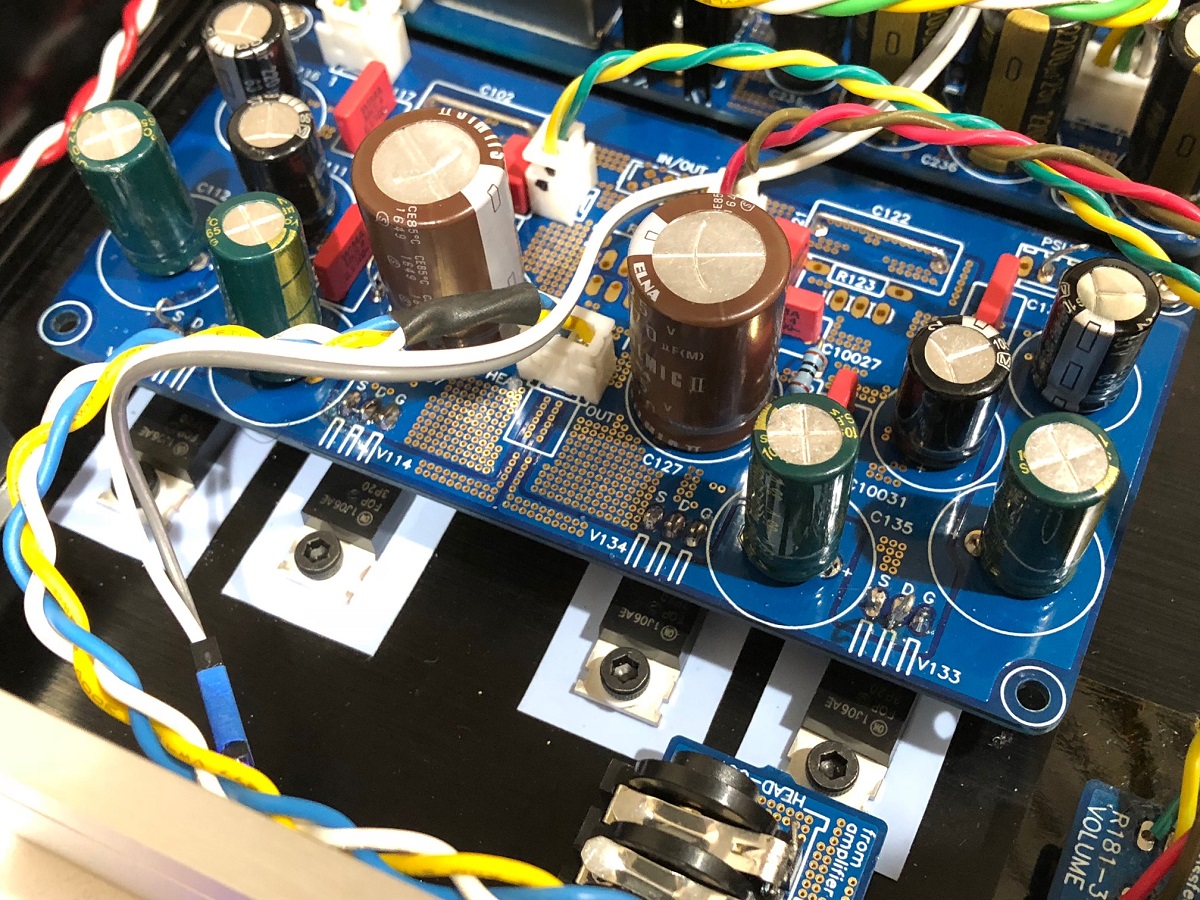
Closeup of Xfeed:
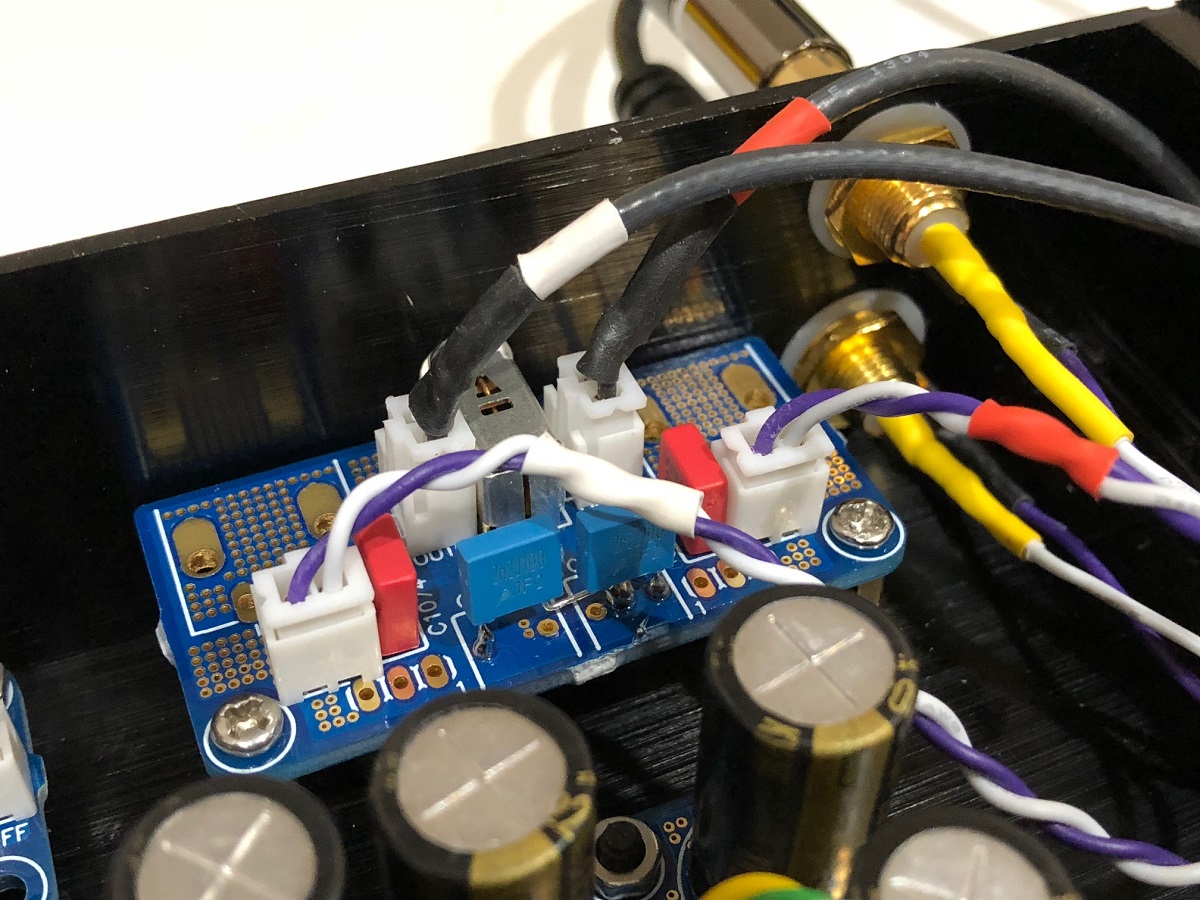
Closeup of vol pot board and headphone jack board:
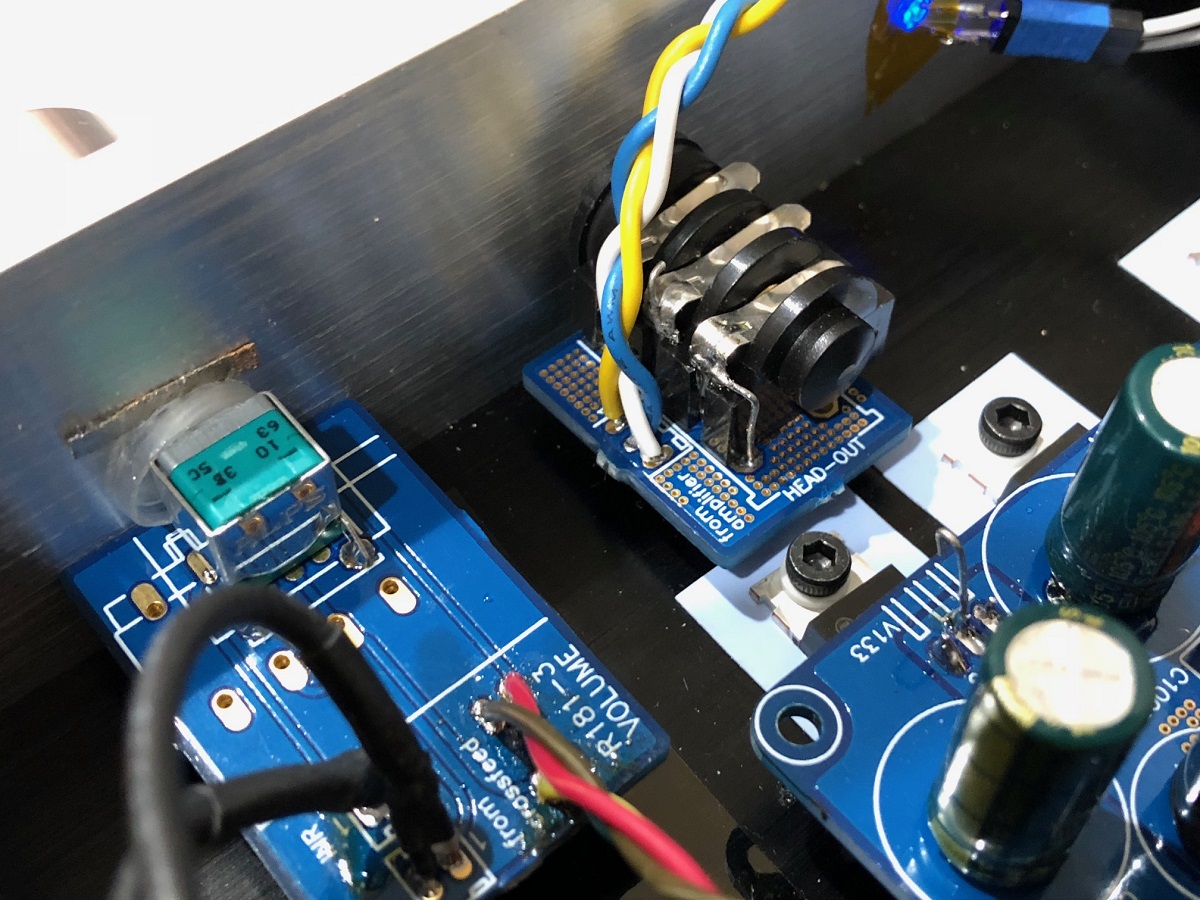
Amp with headphones and Cayin N3 playing:
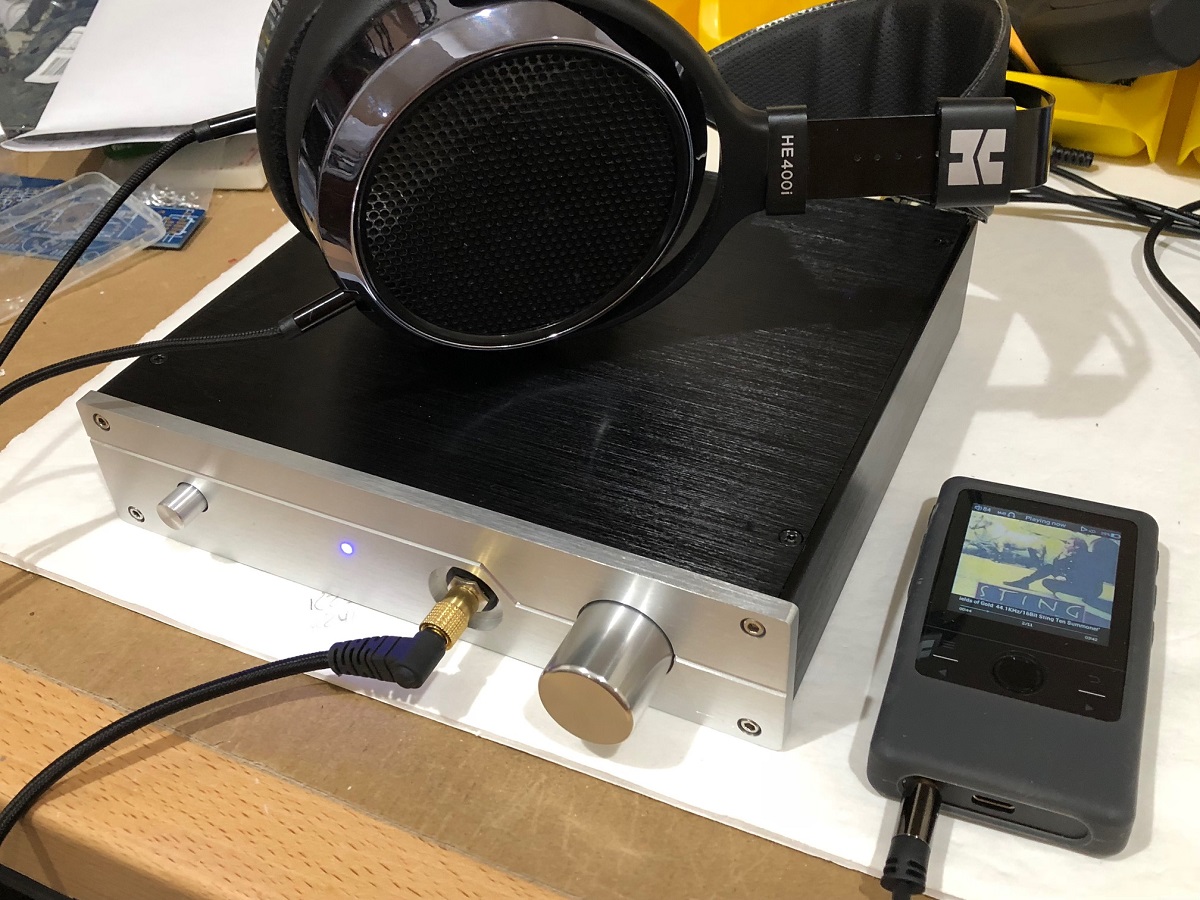
Underside panel showing all the screw holes used to mount parts on the other side:
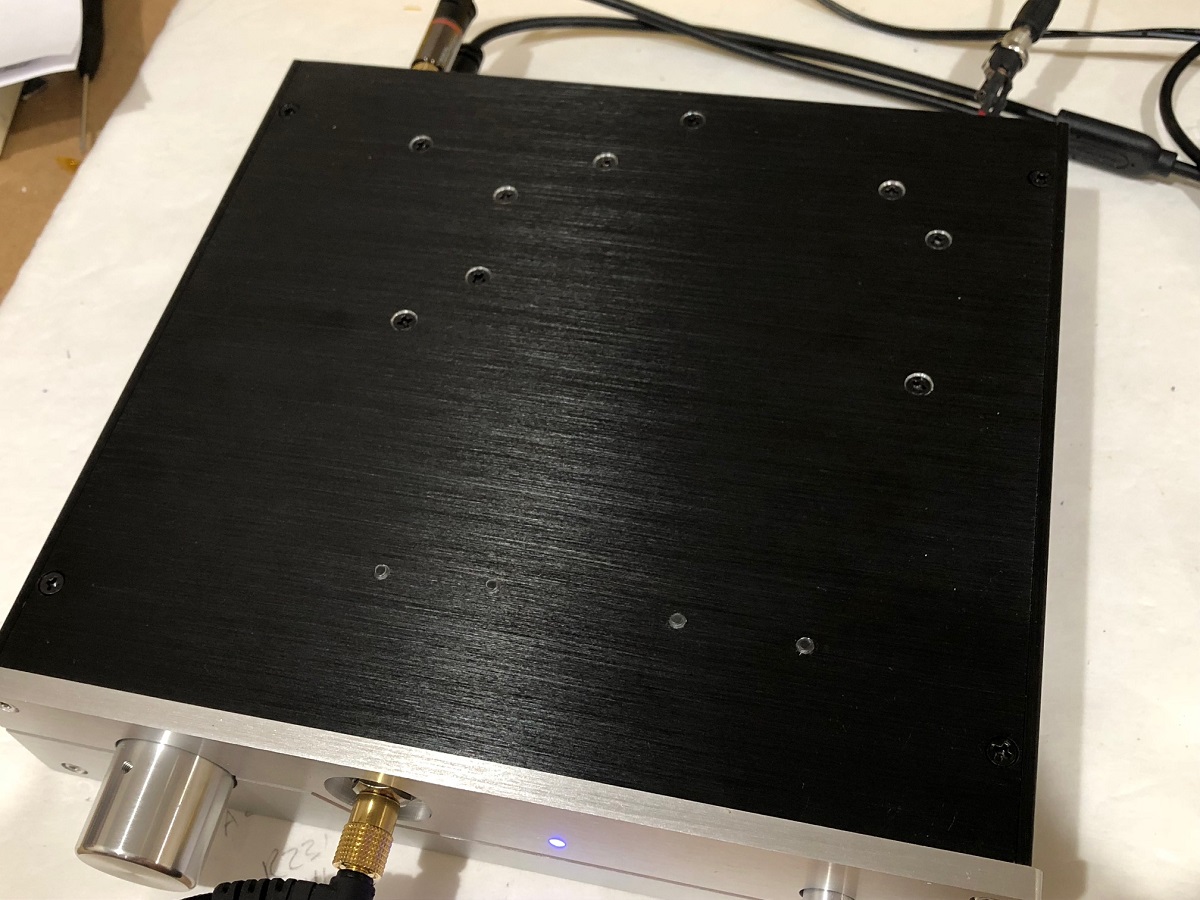
I finally had a good day to work on this amp. The build went together well. It's a big project with all the little sub boards. There is an error on the volume pot board - one of the pads on the smaller right channel is not connected to anything - jumper it to the right input. The crossfeed filter has some errors - I managed to fix it partially so that it works but the defeat feature does not fully defeat it. Sounds great. Bias is 116mA with +/-17.5v under load. DC offset is -2mV and 6mV.
Completed amp before buttoning up:
Closeup:
Closeup of ebay voltage regulator (negative one):
Closeup of outputs and heatsink mounting:
Closeup of Xfeed:
Closeup of vol pot board and headphone jack board:
Amp with headphones and Cayin N3 playing:
Underside panel showing all the screw holes used to mount parts on the other side:
Attachments
-
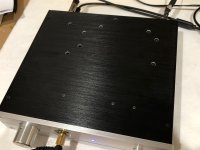 SHPA-GB-Build-08.jpg289.2 KB · Views: 652
SHPA-GB-Build-08.jpg289.2 KB · Views: 652 -
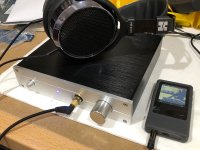 SHPA-GB-Build-07.jpg332.9 KB · Views: 1,807
SHPA-GB-Build-07.jpg332.9 KB · Views: 1,807 -
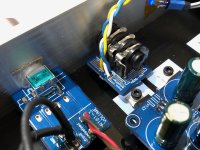 SHPA-GB-Build-06.jpg365.6 KB · Views: 694
SHPA-GB-Build-06.jpg365.6 KB · Views: 694 -
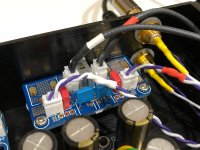 SHPA-GB-Build-05.jpg345.4 KB · Views: 913
SHPA-GB-Build-05.jpg345.4 KB · Views: 913 -
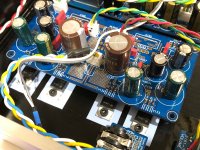 SHPA-GB-Build-04.jpg475.7 KB · Views: 2,150
SHPA-GB-Build-04.jpg475.7 KB · Views: 2,150 -
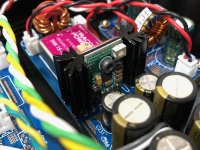 SHPA-GB-Build-03.jpg403.1 KB · Views: 3,907
SHPA-GB-Build-03.jpg403.1 KB · Views: 3,907 -
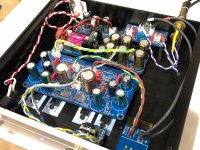 SHPA-GB-Build-02.jpg473.7 KB · Views: 2,199
SHPA-GB-Build-02.jpg473.7 KB · Views: 2,199 -
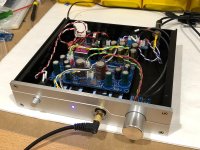 SHPA-GB-Build-01.jpg354.4 KB · Views: 9,034
SHPA-GB-Build-01.jpg354.4 KB · Views: 9,034
Last edited:
Some Measurements
It's a pretty clean amp. I am using my Cayin N3 with 1kHz test tone. The N3 and Focusrite sort of limit the harmonic distortion measurements as the self THD of the DAC is about 0.003% at -1dB FS. I am keeping it in the -10dB to -20dB region.
Here are some FFT's driving a 51ohm 1W metal thin film dummy load resistor.
1.03Vpp into 51ohms:
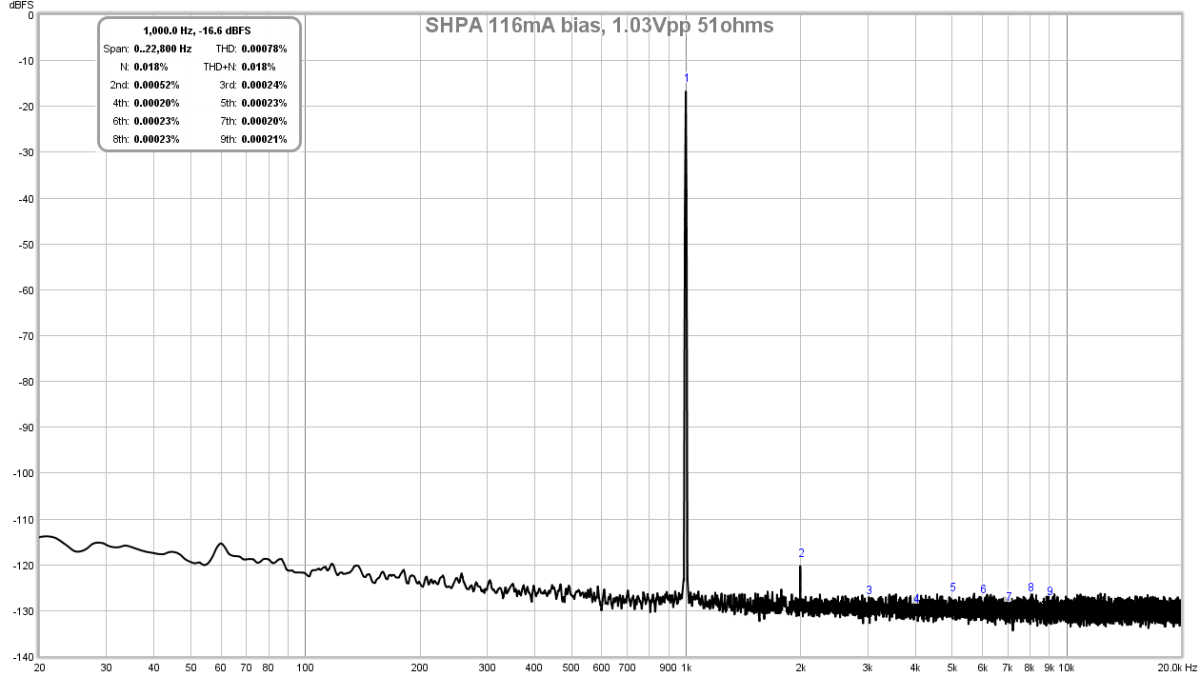
2.76Vpp into 51ohms:
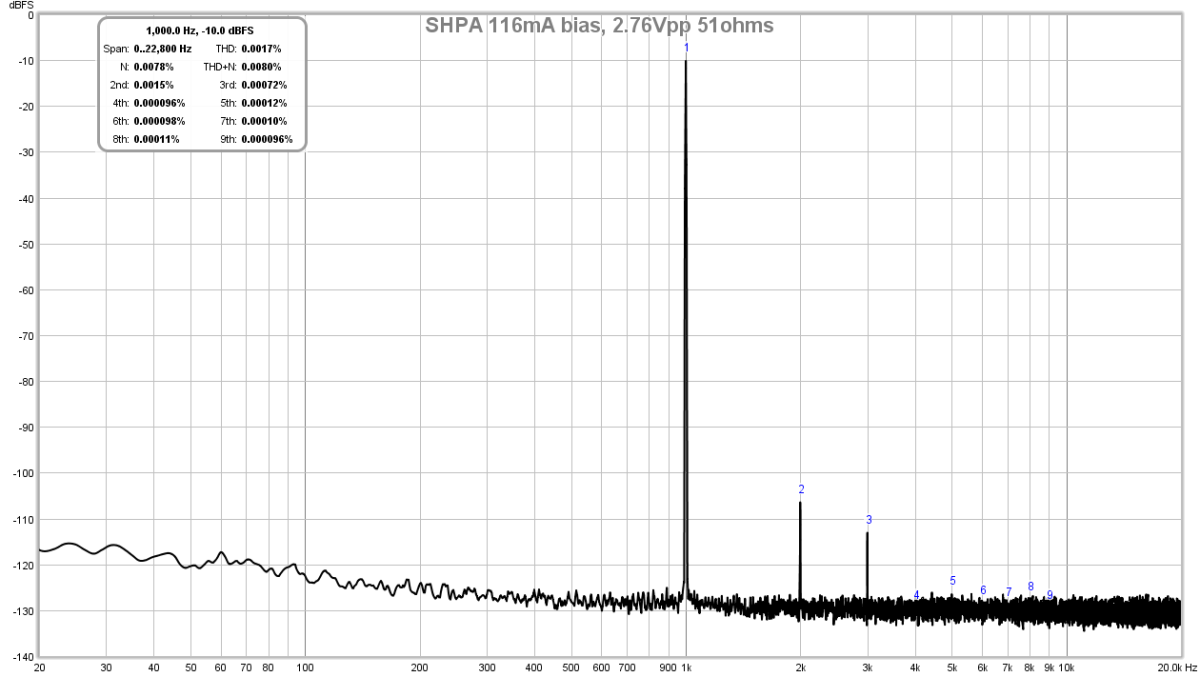
14.0Vpp into 51ohms:
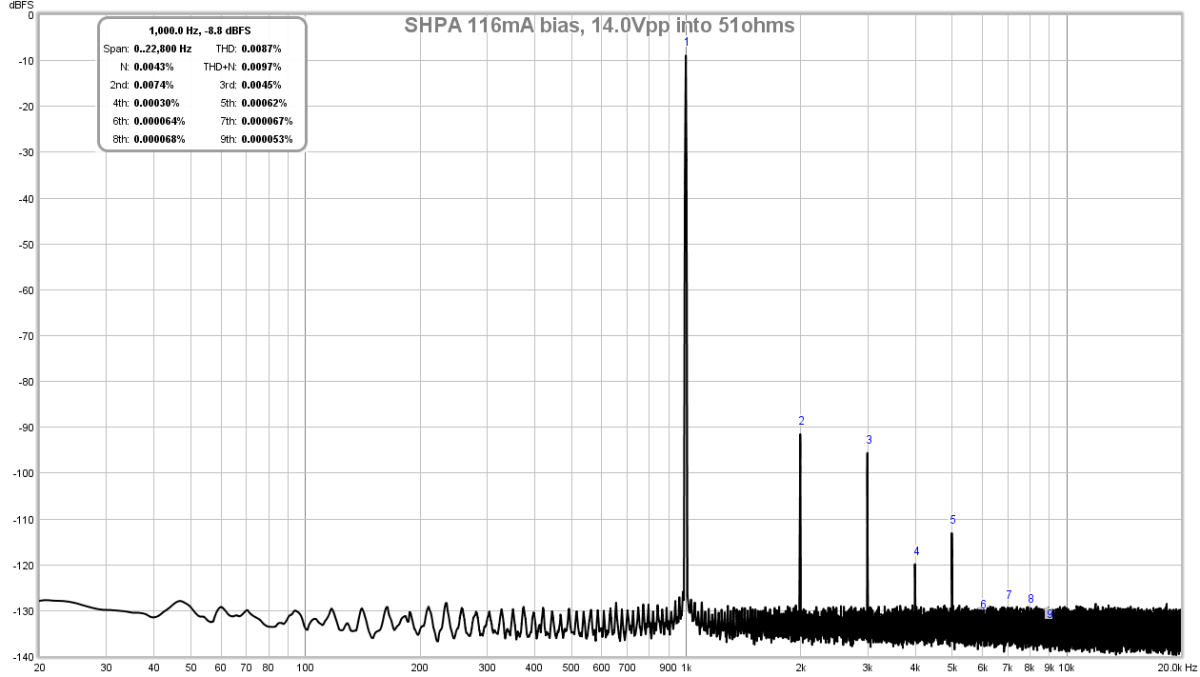
One thing to note is how quiet the power supply is for being a wall plug supply. There is essentially no mains or its harmonics - quiet like a battery.
There is absolutely no audible noise/hiss/hum with the source turned off and the volume turned all the way up with my OB-1's which are 55ohms and 96dB. Normal listening voltage levels with OB-1's are about 100mVrms, so you can get an idea that the data in the plots are for ear blistering levels, or for very insensitive phones.
It's a pretty clean amp. I am using my Cayin N3 with 1kHz test tone. The N3 and Focusrite sort of limit the harmonic distortion measurements as the self THD of the DAC is about 0.003% at -1dB FS. I am keeping it in the -10dB to -20dB region.
Here are some FFT's driving a 51ohm 1W metal thin film dummy load resistor.
1.03Vpp into 51ohms:
2.76Vpp into 51ohms:
14.0Vpp into 51ohms:
One thing to note is how quiet the power supply is for being a wall plug supply. There is essentially no mains or its harmonics - quiet like a battery.
There is absolutely no audible noise/hiss/hum with the source turned off and the volume turned all the way up with my OB-1's which are 55ohms and 96dB. Normal listening voltage levels with OB-1's are about 100mVrms, so you can get an idea that the data in the plots are for ear blistering levels, or for very insensitive phones.
Attachments
Last edited:
Exceptional work, X. A work of art...... and a very nice case too.
At -15dBA input, H2 looks to be around -105dB, H3 maybe -110dB. Very good figures. It should sound very natural?
Hugh
At -15dBA input, H2 looks to be around -105dB, H3 maybe -110dB. Very good figures. It should sound very natural?
Hugh
Last edited:
Thanks, Hugh. It sounds very neutral and very revealing with no caps in signal path. The amp has plenty of headroom for crescendos and will make my headphones recoil on bass kick drum. The casework was a royal pain as you can imagine. Took me better part of a day to assemble. I’m happy with the measured performance and how it sounds. The DC-DC PSU with low noise regulator works very well. It can drive power hungry planar magnetic cans quite admirably. I am using Fairchild TO220 FQP MOSFETs for first time - they sound great.
Hi X, great work!
Did you measure temps inside the case after running it for a while? Seems to be quite closed up enclosure, but i guess there's no that much heat to dissipate with the 116 mA bias...
Did you measure temps inside the case after running it for a while? Seems to be quite closed up enclosure, but i guess there's no that much heat to dissipate with the 116 mA bias...
Hi Morde,
Thanks! With the case open, the actual MOSFETs were 42C and the voltage regulator heatsink was 55C. With case closed I would guess a bit warmer but external temp of case no more than 40C. I would have to quickly remove the lid and take temperatures to know true internal temp.
Thanks! With the case open, the actual MOSFETs were 42C and the voltage regulator heatsink was 55C. With case closed I would guess a bit warmer but external temp of case no more than 40C. I would have to quickly remove the lid and take temperatures to know true internal temp.
- Home
- Group Buys
- Simple High Performance DC Coupled Class A HPA with sub PPM THD
